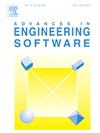考虑平均柔度约束的共轭传热三维拓扑优化:向图形用户界面和原型化迈进
IF 5.7
2区 工程技术
Q2 COMPUTER SCIENCE, INTERDISCIPLINARY APPLICATIONS
引用次数: 0
摘要
热交换器中的共轭传热是许多工业应用的核心。拓扑优化(TO)是一种很有前途的数值方法,它允许从零开始设计高性能的热液系统。然而,全尺寸三维热流体TO仍然主要停留在学术领域,尚未被热工程师轻易探索。为了弥补这一差距,本文提出了一种为共轭传热系统的三维高分辨率拓扑优化量身定制的集成设计工作流程,并结合了平均顺应性约束以确保结构完整性和承载能力。这是在基于密度的TO框架内使用双网格方法实现的。我们还介绍了Tanatloc,这是一个用JavaScript开发的用户友好的图形用户界面,它为热工程师提供了多功能和交互式体验。最后,制作了基于金属的3D打印原型,并进行了逆向工程,利用ct扫描图像重建CAD模型,为未来的实验研究铺平了道路。本文章由计算机程序翻译,如有差异,请以英文原文为准。
3D topology optimization of conjugate heat transfer considering a mean compliance constraint: Advancing toward graphical user interface and prototyping
Conjugate heat transfer in heat exchangers is at the heart of numerous industrial applications. Topology optimization (TO) is a promising numerical method that allows for the design of high-performance thermo-hydraulic systems from scratch. However, full-scale three-dimensional thermofluidic TO remains largely within the academic sphere and has yet to be easily explored by thermal engineers. To bridge this gap, this paper presents an integrated design workflow tailored for three-dimensional, high-resolution topology optimization of conjugate heat transfer systems, incorporating a mean compliance constraint to ensure structural integrity and load-bearing capability. This is achieved using a dual-mesh approach within the density-based TO framework. We also introduce Tanatloc, a user-friendly graphical user interface developed in JavaScript, which provides versatile functionalities and an interactive experience for thermal engineers. Finally, a 3D printed metal-based prototype is fabricated, and reverse engineering is conducted to reconstruct a CAD model using CT-scan images, paving the way for future experimental investigations.
求助全文
通过发布文献求助,成功后即可免费获取论文全文。
去求助
来源期刊

Advances in Engineering Software
工程技术-计算机:跨学科应用
CiteScore
7.70
自引率
4.20%
发文量
169
审稿时长
37 days
期刊介绍:
The objective of this journal is to communicate recent and projected advances in computer-based engineering techniques. The fields covered include mechanical, aerospace, civil and environmental engineering, with an emphasis on research and development leading to practical problem-solving.
The scope of the journal includes:
• Innovative computational strategies and numerical algorithms for large-scale engineering problems
• Analysis and simulation techniques and systems
• Model and mesh generation
• Control of the accuracy, stability and efficiency of computational process
• Exploitation of new computing environments (eg distributed hetergeneous and collaborative computing)
• Advanced visualization techniques, virtual environments and prototyping
• Applications of AI, knowledge-based systems, computational intelligence, including fuzzy logic, neural networks and evolutionary computations
• Application of object-oriented technology to engineering problems
• Intelligent human computer interfaces
• Design automation, multidisciplinary design and optimization
• CAD, CAE and integrated process and product development systems
• Quality and reliability.
 求助内容:
求助内容: 应助结果提醒方式:
应助结果提醒方式:


